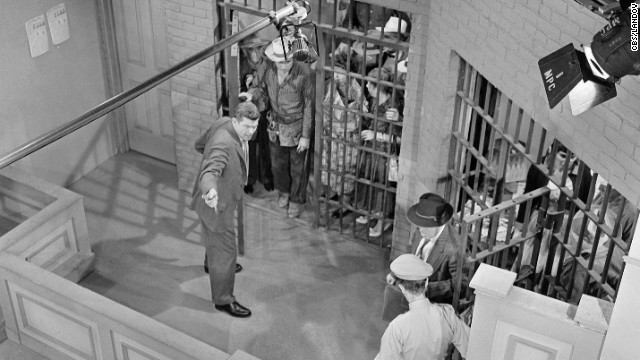
The tranquil, sun-dappled streets of Mayberry, North Carolina, exist in the collective American consciousness as a timeless haven of simplicity, homespun wisdom, and gentle humor. "The Andy Griffith Show," with its memorable characters and moral lessons, painted an idyllic portrait of small-town life. Yet, like any enduring work of art, Mayberry was not static; it evolved, adapted, and sometimes, irrevocably changed. These shifts were often not born from new plotlines conceived in a writers' room, but from pivotal "off-screen moments" – decisions, departures, and personal evolutions that rippled through the fictional town, reshaping its comedic heart, its narrative direction, and its enduring legacy forever.
Perhaps the most seismic shift to shake Mayberry’s foundations came with the departure of Don Knotts, the inimitable Barney Fife. From the show's inception, the comedic dynamic between Andy Taylor, the straight-laced, folksy sheriff, and his bumbling, overzealous deputy was its bedrock. Barney, with his single bullet, his misplaced bravado, and his penchant for getting into scrapes, was the perfect foil to Andy’s calm demeanor. This off-screen partnership, born of a real-life friendship and a shared comedic genius between Andy Griffith and Don Knotts, was the show’s engine. However, as the series entered its fifth season, Knotts, driven by a desire to pursue a burgeoning film career and the limitations of his initial five-year contract, made the difficult decision not to renew his agreement as a regular. His final appearance as a series regular in "Opie and the Carnival" in 1965 wasn't just a character leaving; it unmoored the comedic bedrock of the show. Andy Griffith, no longer having Barney's exaggerated neuroses to play off, had to shift his own character. He became less of the exasperated, subtly humorous straight man and more of a wise, benevolent patriarch. The show itself grew gentler, more focused on community and the challenges of raising a child, moving from overt physical comedy to a more subtle, character-driven humor. While Knotts returned for memorable guest appearances, the original, iconic Andy-Barney dynamic—the very soul of Mayberry's humor—was irrevocably altered.
Another significant off-screen moment that directly impacted the show's landscape was the meteoric rise in popularity of Jim Nabors' character, Gomer Pyle. Introduced as a simple-minded, guileless gas station attendant in the third season, Gomer quickly endeared himself to audiences with his wide-eyed innocence and distinctive "Goooolly!" catchphrase. His popularity, entirely an organic phenomenon spurred by Nabors' unique comedic timing and genuinely sweet nature, led to an unprecedented decision behind the scenes. In 1964, the network greenlit a spin-off series, "Gomer Pyle, U.S.M.C." The creation of this new show meant Gomer's character had to depart Mayberry, joining the Marines. This off-screen strategic move, capitalizing on a breakout character's success, fundamentally changed the population and dynamic of Mayberry. It opened a vacancy in the gas station and in the show's comedic ensemble, leading to the introduction of Gomer's cousin, Goober Pyle (played by George Lindsey). While Goober maintained some of the Pyle family's naivety, his character was distinct, less innocent, and more prone to specific eccentricities like his hat and car imitations. The show adapted, certainly, but the original Gomer, a character so organically embraced by viewers, was no longer a regular fixture, forever changing the specific brand of gentle humor he brought to the town square.
Finally, less a single "moment" and more an ongoing, inevitable off-screen evolution, was the maturation of Ron Howard. From his earliest appearances as the six-year-old Opie Taylor, Howard was more than just a child actor; he was the emotional heart of the show. His growth from a mischievous boy to a conscientious teenager mirrored the passing years in real-time. This organic off-screen development compelled the writers to mature the show's narratives. Opie's problems shifted from losing his fishing worm or struggling with simple chores to grappling with more complex moral dilemmas, first crushes, and the budding pains of adolescence. Andy, as a character, was consequently forced to evolve as a father figure. He transitioned from teaching simple lessons about honesty and sharing to guiding his son through the intricacies of peer pressure, responsibility, and independent decision-making. This off-screen reality—Ron Howard growing up—forever deepened the show's emotional core, moving it beyond mere comedy into a nuanced exploration of parenthood and the passage of time. The final season, without Barney and with a nearly adult Opie, felt markedly different, reflecting the maturity of its characters and, by extension, its audience.
The enduring charm of Mayberry lies not just in its idealized vision, but in its surprising adaptability. The off-screen decisions and inevitable changes—Don Knotts' pursuit of a film career, Jim Nabors' accidental stardom leading to a spin-off, and Ron Howard's natural progression from child to young man—were not flaws but defining moments. They forced "The Andy Griffith Show" to reinvent itself, to delve deeper, and to find new comedic and dramatic veins to tap. These crucial moments behind the camera ensured that Mayberry, rather than remaining frozen in time, became a living, breathing testament to the gentle ebb and flow of life itself, forever changing its landscape, but never diminishing its soul.
